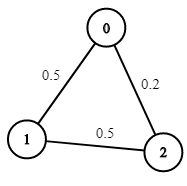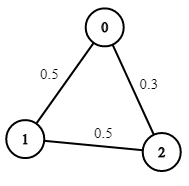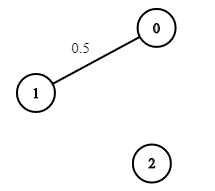1514. Path with Maximum Probability
1514. Path with Maximum Probability
Description
Difficulty: Medium
Related Topics: Array, Graph, Heap (Priority Queue), Shortest Path
You are given an undirected weighted graph of n nodes (0-indexed), represented by an edge list where edges[i] = [a, b] is an undirected edge connecting the nodes a and b with a probability of success of traversing that edge succProb[i].
Given two nodes start and end, find the path with the maximum probability of success to go from start to end and return its success probability.
If there is no path from start to end, return 0. Your answer will be accepted if it differs from the correct answer by at most 1e-5.
Example 1:

1 | Input: n = 3, edges = [[0,1],[1,2],[0,2]], succProb = [0.5,0.5,0.2], start = 0, end = 2 |
Example 2:

1 | Input: n = 3, edges = [[0,1],[1,2],[0,2]], succProb = [0.5,0.5,0.3], start = 0, end = 2 |
Example 3:

1 | Input: n = 3, edges = [[0,1]], succProb = [0.5], start = 0, end = 2 |
Constraints:
2 <= n <= 10^40 <= start, end < nstart != end0 <= a, b < na != b0 <= succProb.length == edges.length <= 2*10^40 <= succProb[i] <= 1- There is at most one edge between every two nodes.
Hints/Notes
- Dijkstra algorithm
- Since the algorithm requires positive edge weights, when dijkstra algorithm reaches the
destination, we can early return since the accumulation of edge labels along any path must
have a monotonically non-decreasing partial order
Solution
Language: C++
1 | class Solution { |